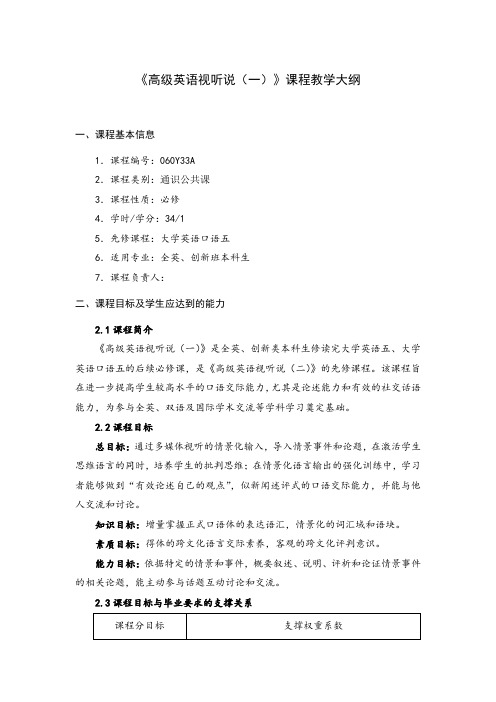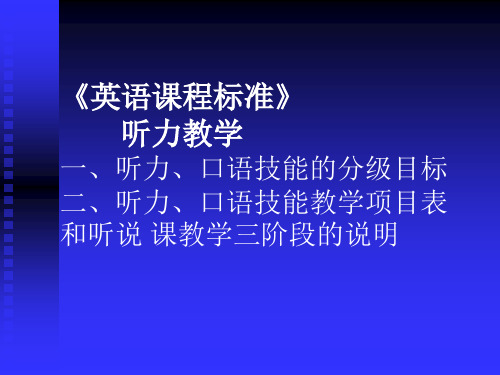课程标准(英语视听说1).doc
- 格式:doc
- 大小:76.50 KB
- 文档页数:5

《酒店英语视听说》课程标准课程名称:《酒店英语视听说》学时:80(一)课程定位英语视听说课程是一门语言技能训练课程,也酒店管理专业一门主要的专业必修课程,在整个专业课程体系中居于基础地位。
行业需求调查显示,随着旅游业日益兴旺,酒店需要大量的英语人才来从事对外接待服务工作。
所以英语的听说能力是学生们就业的保障。
(二)课程设计思路酒店英语学习是个循序渐进的过程,首先要培养口语的基本语言能力。
通过有效的正音训练打破学生“惧怕英语”的这个心结,从根本上激发学生的学习兴趣和自学能力,进而掌握基本酒店用语的词汇、语法知识及简单的会话;其次要培养口语的社会语言能力,理解语言国的文化,准确的运用口语;再次培养口语的策略能力,设计生活及工作场景进行语言职业能力的培养,灵活、有效的运用语言的各种练习、实习及模拟实训。
(三)与其他课程的关系(四)课程的目标(1)知识目标掌握酒店业的基本英语词汇,掌握前台,客房,餐饮等服务英语用语,操作程序,服务规范,产品介绍等细微环节中英语表达方式。
(2)能力目标通过本课程的学习,使学生具有运用英语进行交际的能力和继续学习的能力。
让学生了解文化差异,树立良好的酒店职业道德风尚,具有较强的英语口语表达能力,使他们能运用酒店英语专业基础知识及较强的英语交际能力(跨文化交际)为客人提供酒店服务,并能注意在跨文化交际上语言或非语言行为与文化背景的关系,正确运用英语为客人服务,培养从事涉外酒店专业所需的人才。
(3)社会目标通过该课程的学习让学生树立良好的酒店职业道德风尚,具有一定的敬业精神。
五)、教学建议与进度要求(六)教材选择1.教材选取原则视听说课程的教材选用体现了以下原则:充分体现任务引领、实践导向的课程设计思想;突出实用性和前瞻性,教学内容紧密结合行业前沿信息,将酒店真实内容引入课堂教学,让学生体验真实的酒店世界;教材以学生为本,设计严谨、突出重点,重在提高学生学习的参与性和积极性,能有效激发学生的学习兴趣;教材中配套练习的设计具有可操作性2.推荐教材:(1).版本:外研社(2).主编:郑毅杜刚(3).书号: ISBN 97875600942293.参考资料:饭店工作英语,中国旅游出版社(七)课程教学资源的使用与建设(1)利用现代信息技术开发录像、光盘等多媒体课件,通过搭建多维、动态、活跃、自主的课程训练平台,使学生的主动性、积极性和创造性得以充分调动。

《高级英语视听说(一)》课程教学大纲一、课程基本信息1.课程编号:060Y33A2.课程类别:通识公共课3.课程性质:必修4.学时/学分:34/15.先修课程:大学英语口语五6.适用专业:全英、创新班本科生7.课程负责人:二、课程目标及学生应达到的能力2.1课程简介《高级英语视听说(一)》是全英、创新类本科生修读完大学英语五、大学英语口语五的后续必修课,是《高级英语视听说(二)》的先修课程。
该课程旨在进一步提高学生较高水平的口语交际能力,尤其是论述能力和有效的社交话语能力,为参与全英、双语及国际学术交流等学科学习奠定基础。
2.2课程目标总目标:通过多媒体视听的情景化输入,导入情景事件和论题,在激活学生思维语言的同时,培养学生的批判思维;在情景化语言输出的强化训练中,学习者能够做到“有效论述自己的观点”,似新闻述评式的口语交际能力,并能与他人交流和讨论。
知识目标:增量掌握正式口语体的表达语汇,情景化的词汇域和语块。
素质目标:得体的跨文化语言交际素养,客观的跨文化评判意识。
能力目标:依据特定的情景和事件,概要叙述、说明、评析和论证情景事件的相关论题,能主动参与话题互动讨论和交流。
2.3课程目标与毕业要求的支撑关系注:任课教师依据课程情况具体调整目标项及权重三、课程教学内容与学时分配注:教师依据所选教材内容填写教学日历和具体教学内容,基本为2学时一个单元,围绕教材和现实语境资料情况安排教学。
四、课程教学方法借助多媒体信息手段,以视、听情景声、像输入辅助文本教材,设置交际情景,激活学生的情景记忆和交际语言;以学生主题陈述、情景训练、师生交际互动、角色参与、辩论等形式进行实训教学;以媒体的情景化、直观化和形象化,鼓励和引导学生在真实的语境中强化和巩固口语交际技能,尤其是情景事件的口语概述、说明和论说能力。
五、课程的考核环节及课程目标达成度评价方式5.1课程的考核环节实训类课程重在能力、素养和技能的过程训练和学习,因此,过程中的形成性考核占50%,重点考核过程训练中的学勤、课堂参与及表现、课外辅助学习的展示、口语能力与交际行为方式等;终结性考核占50%,采用实践技能测试形式,两位口语测试教师一组,对2到3位同学在给定的情景中陈述、叙事、对话与交流。


《英语视听说基础》教学大纲一、课程类别:公选课二、课时:30三、学分:2分四、教学性质与目标:英语视听说基础是一门针对英语基础薄弱的学生开设的公选课,以“听说领先,实用为本,重在应用”为目标,通过“视”、“听”、“说”三位一体的立体式教学,发挥和利用现代化的科技手段,以文本,视频,音频和图像等各类视听材料开展有针对性的基础训练,全面提升学生的英语水平,快速提高他们学习英语的兴趣,同时增强学生的自主学习能力,为今后的英语学习打下一个良好的基础。
目标:课程结束时,学生应能运用简单的日常英语进行对话,并能就所听所读的材料回答问题及复述,做到语音、语调、语法基本正确。
五、教学的内容和要求:本课程将英语语言技能与语言文化、学科专业知识有机结合起来,提高学生的听说技能和对语言运用的分析理解能力。
首先通过系统的音标训练纠正以往错误的发音;其次结合一系列由浅入深,精泛结合的视听训练,使学生能基本听懂日常用语;之后再通过形式多样,模拟真实交际情景的口语训练,使学生能就一般性话题进行比较流利的会话,表达个人意见、情感和观点。
另一方面,通过介绍英美及本地风俗和文化特色来扩大学生的知识面,因此实用性强、趣味性浓,视听内容丰富。
该课程一定要在多媒体教室上课,并要求学生做到眼到、耳到、手到、心到,积极参与课堂讨论。
六、课时分配:七、所用教材及参考书目:1.李超《全新大学英语视听说教程(上册)》,上海外语教育出版社,2007版2.《走遍美国》外语教学与研究出版社,1993年出版3.自选音像材料八、考核方式:该课程为考查课,学期成绩分为平时和考查成绩,其中平时成绩占50%,考查成绩占50%。
期末考试采用视听结合的方式,要求学生在一定的时间内边观看或边听视听材料,边完成教师设计的题目。

初中英语听力课程标准(一)初中英语听力课程标准背景介绍•初中英语听力课程是目前中国教育体系中不可或缺的一部分。
•该课程的目的是为学生提供英语语音、语调、速度等方面的训练,帮助他们更好地理解和应用英语,为其日后的学习和职业生涯打下坚实基础。
课程要求•每周至少两课时的英语听力培训,总学时不少于60学时。
•教材选用紧扣学生水平的听力教材,以及包含多种语言元素的听力材料。
•学生需要完成针对不同题型的听力练习、词汇练习、语感训练等。
•学生要求达到较高的听力水平,能够听懂日常生活中的英语,包括但不限于电影、音乐、广播电视、新闻资讯等。
评分标准•各类练习均采用专用的评分标准,对学生的听力水平进行准确评估,并予以相应的反馈及提醒。
•以学期末为评估时间节点,将学生在练习和考试中的得分汇总,为学生制定个性化的指导计划。
•评分标准的精细化和科学化是保证“初中英语听力课程标准”有效性的基础。
教学方法•借助创新的技术手段,如语音识别、多媒体播放、虚拟场景的使用等,来帮助学生更好的进行英语听力训练。
•采用多样化的教学方法,如集体教学、小组合作、个性化指导等,以此来提高学生听力练习的积极性和效率。
•引导学生积极参与课堂讨论、听力练习,鼓励他们多说英语,从而提高他们的听力水平和语言能力。
总结初中英语听力课程标准不仅是教育体系中不可或缺的一部分,更是学生未来学习和职业生涯中必不可少的一项能力。
制定标准,严格实施评估,科学教学方法的使用,都是保证英语听力教学效果的关键。
建议•学生应该根据学校提供的教材,自主学习,多参加听力练习,提高英语听力水平。
•学生应该积极向老师请教,解决听力上的难题,结合听力材料做一些听力笔记,加强对英语语言特点的理解和记忆。
•学校应该选用紧跟时代、课程丰富、内容有趣的听力教材并不断创新,精准地添加指导目标,以此来更好地吸引学生,让学生更加主动地参与听力学习。
•教师应该认真评估和记录学生的听力水平,结合学生的实际情况,制定个性化的听力训练计划,帮助学生把握重点,加强听力技巧的练习。

商务英语专业核心课程标准“英语视听”课程标准一、课程概述《英语视听》课程是商务英语专业学生的必修课,是一门以英语听力为主,集“视”、“听”、“说”为一体的英语专业技能课程。
英语听力教学是商务英语专业教学中最基本、最关键的一环,因为英语视听说能力的培养自始至终都是英语学习中最基础、最核心的任务之一。
本课程以培养学生在商务环境下实际的听说能力为目的,使其有较好的英语的听的能力,能基本听懂欧美人士及其他国家人士用正常速度讲英语。
其主要任务在于通过多种形式的训练,组织学生收听大量精选的各种题材和体裁的有声材料,培养学生们听英语时的快速反应能力和理解能力,提高学生的实际运用英语的能力和商务活动能力。
通过该课程的系统学习,训练学生为其他技能的学习与提高打下良好的基础。
《英语视听》(1)针对商务英语专业一年级学生在第一个学期开设,侧重语言基础训练,共计28个学时。
二、培养目标1. 方法能力目标培养学生听说读写等综合素质,利用多媒体技术观看商务谈判与国际贸易活动,如:商品交易会、经贸洽谈会等,掌握商务谈判中必备的英语词汇和句型,了解商务英语礼仪知识,熟悉贸易的整个流程,在商务英语活动中游刃有余。
2. 社会能力目标具备商务接待和谈判中的英语听说能力和交际能力,能胜任接待,商务翻译,外贸等职业岗位。
3. 专业能力目标通过组织学生收听大量精选的各种题材和体裁的有声材料,着重训练学生听力的基础技能,在培养学生听懂基本语言单位(如语音、数字、句型等)的基础上,逐步加强学生在语篇水平上的听力理解能力,从而培养学生听英语时的快速反应能力和理解能力,提高学生的实际运用英语的能力和商务活动能力。
三、与前后课程的联系先修课程为综合英语、语音等专业基础课,后续课程为剑桥商务英语、商务英语口译等专业课。
四、教学内容与学时分配五、 学习资源的选用1. 使用教材:本课程使用大连理工大学出版社出版的《世纪商务英语——听说教程I 》(第四版)作为主体教材,进行教学。
新课标英语视听说新课标英语视听说课程是针对当前英语教学改革和学生实际需求而设计的,旨在提高学生的英语听说能力,同时培养他们的跨文化交际能力。
以下是该课程的一些主要内容:1. 课程目标:新课标英语视听说课程旨在培养学生的英语听力理解能力、口语表达能力以及通过视听材料获取信息的能力。
同时,课程也注重培养学生的批判性思维和创新能力。
2. 教学内容:课程内容涵盖日常生活、社会热点、文化差异、科技发展等多个领域。
通过多样化的视听材料,如电影片段、新闻报道、TED演讲等,让学生接触不同语境下的英语使用。
3. 教学方法:采用任务型教学法,鼓励学生在完成特定任务的过程中学习语言。
教师会设计各种听力和口语练习,如角色扮演、小组讨论、辩论等,以提高学生的实践能力。
4. 技能培养:重点培养学生的听力技能,包括捕捉主旨大意、理解细节信息、推断言外之意等。
同时,通过模仿、复述、描述等活动,提高学生的口语表达能力。
5. 文化意识:通过观看不同文化背景的视听材料,让学生了解不同文化的特点和差异,培养跨文化交流的意识和能力。
6. 评价方式:课程评价不仅包括传统的笔试,还包括口语测试、听力理解测试、小组项目展示等多种形式,全面评估学生的英语视听说能力。
7. 技术应用:利用现代信息技术,如多媒体教室、在线学习平台等,为学生提供丰富的学习资源和便捷的学习途径。
8. 课程资源:课程配备有丰富的视听材料库,包括经典电影、纪录片、英语国家的日常对话视频等,以满足不同学生的学习需求。
9. 教师角色:教师在课程中扮演引导者和促进者的角色,通过提问、反馈和指导,帮助学生更好地理解和运用英语。
10. 学生参与:鼓励学生积极参与课堂活动,通过小组合作、个人展示等形式,提高自己的英语实际应用能力。
新课标英语视听说课程通过这些内容和方法,旨在为学生提供一个全面、系统的英语学习平台,帮助他们在全球化背景下更好地掌握英语,提升自身的国际竞争力。
《英语听说》课程标准一、课程定位《英语听说》课程是应用英语专业的专业技能基础核心课程之一,是一门以英语听说技能和英语交际技能为主的,教师职业技能为辅的融实践性、交际性为一体的应用英语专业的必修课。
本门课程实践操作性强,通过专门系统的听说训练,使学生掌握较扎实的综合英语听说技能、英语文化知识和英语教师的基本职业能力,旨在提高学生的英语交际技能和综合教学能力,为英语教师职业能力的进一步发展及中小学英语教学人才的培养打下坚实的基础。
前导课程有《英语语音》、《英语语法与实训》、《英语精读》及《英语泛读》等,同期开设的课程有《英语口语》、《中小学英语教学法与课堂实训》及《翻译理论与实践》,后续课程有《求职英语》。
同时为学生第五学期在中小学校的顶岗实习提供扎实的英语语言基础和今后的就业提供有力的实践准备。
二、课程教学目标本课程旨在通过真实的场景,地道的语言和多样的练习从而达到提高学生的英语听说能力的目标。
通过教师引导学生讨论不同的话题和进行听与说两种技能的训练为形式展开教学活动,每个单元的话题不同,难度由易到难,从而使学生有效地进行英语听与说的联系(或结合)达到更高水平。
具体来说,教师指导学生要达到的教学目标是指每个学年的每个学期学生应按质按量完成教师计划的教学进度表上的安排,并且学生能够真真切切地提高自己的英语交流水平并结合考级考证相关的听力训练,促进课证融合,为学生发展职业能力奠定基础。
这为实现应用英语专业方向的中小学教师岗位群打下坚实的基础。
1、基本知识教学目标(1)熟悉日常话题的英文听与话的技巧,如人名,数字,食品,健康,价目,职业,广告等;(2)掌握相关的常用英语词汇和语句表达模式;(3)掌握获取复杂较难信息的英语听说技巧。
2、职业能力培养目标(1)培养与提高学生的英语语言听说能力;(2)培养学生教学中特殊情况下独立思考,分析问题、解决问题的能力,能够处理课堂上的常见问题和与学生的交流;(3)培养学生的沟通能力及团队协作精神,正确的处理好师生关系。
《Listening and Speaking 1》课程教学大纲一、教师或教学团队信息二、课程基本信息课程名称(中文):英语听说 1课程名称(英文):Listening and Speaking 1课程类别:□通识必修课□通识选修课 专业必修课□专业方向课□专业拓展课□实践性环节课程性质*:□学术知识性 方法技能性□研究探索性□实践体验性课程代码:0410113周学时:2 总学时:32 学分: 2先修课程:无授课对象:本科一年级三、课程简介英语听力是我院英语专业学生必修的一门专业基础课程。
该课程改进原来的以教师讲授为主的单一课堂教学模式,充分利用现代化信息技术,以学生为主体,教师为主导,采用多媒体和课堂相结合的英语听力教学模式。
教学目的是培养学生英语听、说应用能力,特别是加强听的能力,扩大知识面,提高文化素养。
使他们在今后工作和社会交往中能用英语有效地进行口头信息交流,同时增强其自主学习能力、提高综合文化素质。
四、课程目标英语听力课程教学是以英语语言知识与应用技能、学习策略和跨文化交际为主要内容,以外语教学理论为指导,并集多种教学模式和教学手段为一体的教学体系。
英语听力课程教学目的是要培养学生英语综合应用能力,特别是听说能力,使他们在今后的工作交往中能用英语有效进行口头的信息交流。
五、教学内容与进度安排*六、修读要求(满足对应课程标准的第3条)课程学习要求学生按时上课,按时交作业。
考试中严格要求学术诚信。
课堂内外学习应达到1:1的标准,也就是1节课的课内教学会安排学生1节课时间的课外操练,教师在学期开始时就把课程学习的要求交代清楚。
七、学习评价方案本课程的考核与评价规则包括1.每堂课的课内都有笔头和书面的作业,这些作业都以平时分算入学期总评2.期中考试没有固定的形式,课程会以学期的项目展示(与课文内容相关的presentation)作为期中成绩评价形式和评价标准3.学生的课堂表现、课后作业都计入平时分数计入总分等部分。
《英语视听说1》课程标准
1.课程基本信息
课程代码: A130318 适用专业:英语教育
学时数: 52 学分:3
先修课程:无
后续课程:《英语视听说2》、《中级综合英语》等
2.课程性质
本课程是英语教育专业的专业核心课程。
《英语视听说》是专门培养学生“听”和“说”的能力的一门课程,旨在使学生通过收看一些三分钟的英文视频,收听一些100字以内的英文录音(包括英文对话,英文短文),提高学生对英语语言的理解,增强对语言的敏感性、灵活性。
切实培养学生的英语听力能力以及对语言的运用能力。
通过学习,使学生能听懂英文录音的主要内容,回答和录音内容相关的问题;能复述英文视频的主要内容,模拟视频中的情景对话。
它是进一步学习《英语视听说2》、《中级综合英语》、等课程的基础,也是学生今后从事小学英语教育必不可少的基础。
3.课程教学目标
3.1 能力目标
A1. 能在10分钟内(听两遍)听懂100字以内的英文材料的主要内容;
A2. 能复述听力材料中关键的单词和句子;
A3. 能回答和听力材料相关的问题;
A4. 能看懂3分钟左右的英文短片的大意并且能表述短片的大意;
A5. 能模拟视频中的情景对话或演讲;
A6. 能够较流畅地用英语进行日常情景交际;
3.2知识目标
K1. 掌握图形法、缩略法等听力速记的方法和技巧;
K2. 了解100字左右的听力英语材料中的常用词汇和句式;
K3. 掌握问候、打招呼、问路等日常生活情景下英语的基本表达方法;
K4. 熟悉自我介绍、信息交流等口语表达法。
3.3素质目标
Q1. 培养团队协作精神。
Q2. 培养良好的跨文化交际意识。
Q3. 培养良好的人文素质。
4.课程设置与设计思路
4.1该门课程设置课程目标、课程内容确定的依据
目标:本专业主要培养小学英语教师,本课程针对三年制大专的学生的英语听说能力进行系统的锻炼,教授学生听力及口语表达方法和技巧,从中西文化差别的独特视角进行教学设计,培养学生良好的英语学习习惯以及人文素养,为其他课程奠定基础,同时也为毕业之后的小学英语教学工作打下坚实的基础。
依据:本课程设置的主要依据是以职业能力为核心。
教学内容根据学生的认知水平而定,都是日常生活情景对话或者情景视频,教学的重点针对学生就业的岗位而定,教学的程序也是由浅入深,由易到难,从听到说再到表演,情景教学,听说互动。
4.2课程内容选择、设计的思路。
本课程以中国留学生王新到美国进行学位进修,在美国的学习及生活情况为贯穿项目,分为自我介绍、问路、聊天等教学模块。
在整个过程中,学生将会学习并且掌握寒暄问候、、询问方向,描述学校生活等一系列活动的英语表达方式。
4.3课程项目设计参考表(见附录)。
5.教学内容与学时分配
表1: 课程内容与学时分配表
6.教学资源开发与利用
6.1教材与参考资料
教材:
《英语视听说教程》外语教学与研究出版社
辅助参考书和工具:
《英汉词典》、《英语语法》、《走遍美国》等
7.考核方式与考核标准
考核成绩包括形成性考核(100x40%)和总结性考核(100x60%)两部分。
●形成性考核(40%)
➢平时成绩(10%):考勤(5%)、学习态度(5%);
➢项目成绩(30%):包括课内项目成绩和课外项目成绩,具体分值见下表2;
●总结性考核(60%)(实务考核--口试)
➢题型为看图说话。
表2: 项目考核评分标准
执笔人:唐莉专业主任:王莉院长:罗春娜
教务处长:袁光华主管校长:陈德清制定时间:XXXX.09
5。